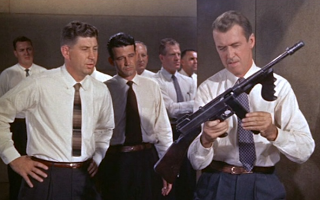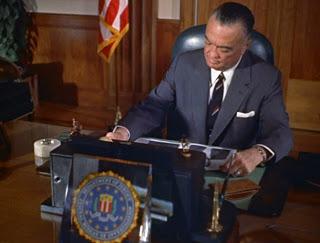 J. Edgar Hoover used Hollywood to burnish his image for decades. Mervyn LeRoy's The FBI Story (1959) is the magnum opus of Bureau propaganda, a 149 minute paean to America's premier police agency. With James Stewart's help, it remolds a controversial organization into the benevolent defender of American freedom.
J. Edgar Hoover used Hollywood to burnish his image for decades. Mervyn LeRoy's The FBI Story (1959) is the magnum opus of Bureau propaganda, a 149 minute paean to America's premier police agency. With James Stewart's help, it remolds a controversial organization into the benevolent defender of American freedom.Chip Hardesty (James Stewart) abandons a promising law career to work for the Federal Bureau of Investigation. From 1924 through 1955, Hardesty becomes the FBI's top agent, battling bank robbers, fascist saboteurs, corporate crooks and the Ku Klux Klan. Hardesty suffers friction with his wife Lucy Ann (Vera Miles), who constantly nags Chip to leave the Bureau; he also mentors George Crandall (Larry Pennell), son of his slain partner (Murray Hamilton). In the '50s, Hardesty runs into America's most dastardly enemy yet: Communism.
Based on Don Whitehead's nonfiction book, The FBI Story feels like an extended TV pilot. Hardesty battles nefarious mountebanks in self-contained episodes spanning decades, while dealing with treacly domestic issues. Lucy Ann repeatedly demands Chip quit the Bureau until she doesn't, persuaded by loyalty, her son's wartime death and a beanie that plays Yankee Doodle. She becomes a model housewife, encouraging Chip to sublimate his reservations to Hoover's holy crusade.
At their best, LeRoy and writers Richard L. Breen and John Twist provide engaging mini-procedurals. The opening vignette shows Hardesty tracking Jack Graham (Nick Adams), a real-life killer who bombed an airplane to collect on life insurance. The FBI sifts through evidence, with experts using chemical signatures and metal fragments to finger the killer. This shows the Bureau as Hoover's self-image: thorough, efficient, sophisticated crime fighters. We could almost swallow FBI Story's hagiography, if we're ignorant of Bureau history.
Hoover micromanaged the production, ensuring it painted his G-Men as squeaky clean heroes. There's no hint of Hoover's compiling dirt on media and political figures or firing agents over rumpled shirts and undue media attention. A super-agent like Hardesty was unlikely: his closest equivalent, Melvin Purvis, was sacked for stealing Hoover's spotlight. Showing the FBI battle the Klan especially sticks in one's craw, considering their later harassment of Martin Luther King and other Civil Rights leaders.
 Anyone who's read Bryan Burrough's Public Enemies or seen its film adaptation knows Hoover exploited '30s bank robbers, both for media coverage and to expand Bureau powers, while ignoring organized crime. FBI Story follows the official line, staging the Kansas City Massacre, John Dillinger's ambush and Baby Face Nelson's demise in flattering fashion. The botched Little Bohemia raid is blamed on barking dogs rather than Bureau incompetence. Hoover really did arrest Alvin Karpis, but only after he'd been disarmed by other agents.
Anyone who's read Bryan Burrough's Public Enemies or seen its film adaptation knows Hoover exploited '30s bank robbers, both for media coverage and to expand Bureau powers, while ignoring organized crime. FBI Story follows the official line, staging the Kansas City Massacre, John Dillinger's ambush and Baby Face Nelson's demise in flattering fashion. The botched Little Bohemia raid is blamed on barking dogs rather than Bureau incompetence. Hoover really did arrest Alvin Karpis, but only after he'd been disarmed by other agents.Later, Hardesty offhandedly justifies Japanese internment during WWII (oddly, considering Hoover opposed it in real life). After chasing Nazis across Argentina, Chip returns home to battle the Red Menace. Here Story descends into polemic, with Hardesty's narration damning the dastardly Commies infiltrating our institutions. At one point, Hardesty sneers that a Soviet spy won't be attending church on Sunday! Treason's bad enough, but atheism is unforgivable. At least it's not Clint Eastwood's J. Edgar, which absurdly pretends Hoover hated Joe McCarthy.
James Stewart does his best to sell the propaganda through folksy charm and stentorian narration. Stewart, an avowed conservative, plugs the virtues of a benevolent, all-powerful FBI with conviction. Vera Miles is naggingly shrill, while other players are largely anonymous. Nick Adams makes a memorably shifty crook for his few scenes. Murray Hamilton, as Chip's idealistic partner, makes an impression before dying an hour into the movie.
The FBI Story's fitfully engaging but can't transcend its origins. Like any good American, Chip learns to fight crime, raise a family and trust in God, the United States and J. Edgar Hoover. If only John Dillinger, Alger Hiss and Stokely Carmichael had done likewise, America would be a better place.

